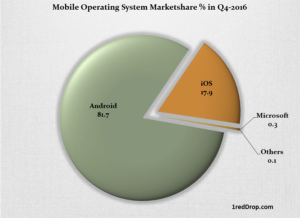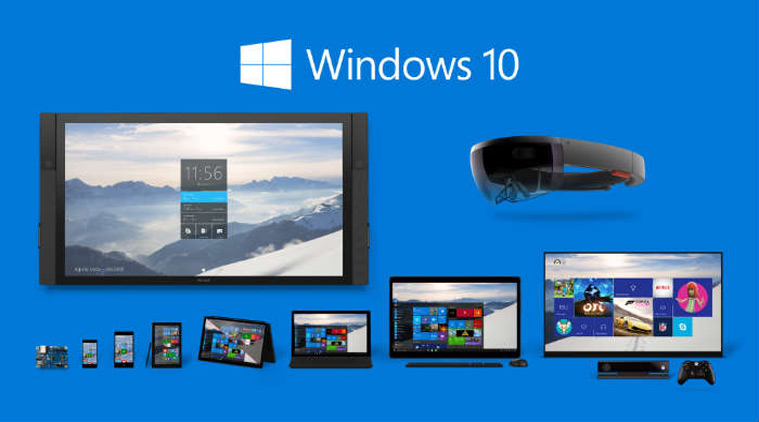Microsoft CEO Satya Nadella has transformed a software giant into a very different kind of company during his time at the helm. The focus has moved towards a “Cloud First, Mobile First” strategy, but we seem to be hearing and seeing a lot of action on the ‘cloud first’ part of that strategy; not so much on the ‘mobile first’ part.

Microsoft is silently working on what is possibly the riskiest and boldest plan it has ever plotted: one that could easily backfire and take the company on a never-ending journey.
And it looks like Microsoft’s position in the mobile operating system world – a 0.3% market share during the fourth quarter of 2016 – has only emboldened the company to go all in, because now there is literally nothing to lose, but everything to gain.
In a recent interview to Business Insider Poland, Microsoft CEO Satya Nadella re-affirmed his commitment to keep blurring the OS boundary across devices.
So when we talk about Windows 10, it’s not about a device operating system anymore, it’s an operating system for all of your devices.
That’s how we’re trying to not only tackle the innovative challenge of bringing new things to life, but also deal with the social complexity of a lot of devices in your life.
– Microsoft CEO Satya Nadella
This is not the first time Nadella is talking about Windows 10 eventually becoming an operating system that can work on multiple devices; he has been talking about if for quite some time, and company’s messaging for Windows 10 has always been the same.
But the argument for separate operating systems for different device types is strong as well. In fact, the biggest validation of that is the macOS vs. iOS dichotomy. If you want to exploit the full potential of every type of device, then the marriage between software and hardware must be a near-perfect one.
People who are really serious about software should make their own hardware.
– Alan Kay
The hardware that goes into one device is not the same as that which goes into another. So, how is it possible to make software that can cut through that difference, yet fully leverage any hardware at its disposal without being an bloated and unwieldy OS?
In many ways, the advent of iPhone and the capacitive touch concept that the iPhone championed was responsible for this divergent development of operating systems for different device types.
What further complicated that situation (not problem, just situation) was that smartphones evolved over the years – to such an extent, in fact, that some top-end smartphones boast of specs that are much better than some of our PCs.
And the technology behind smartphones is getting better every day, bringing with it the very real possibility that, in the near future, a smartphone combined with a monitor might well replace the traditional idea of a PC. Well, not really.
But Samsung is doing it with DeX, Apple fuddled through it with Handoff, and even Google is trying to blur the line between desktops and mobile devices with the Andromeda hybrid OS.
Incidentally, Microsoft has a project going with the exact same name, which basically uses OneCore with different shells.
Windows OneCore
Windows OneCore is a platform for any device—phone, tablet, desktop, or IoT. Windows 10 provides a set of API and DDI interfaces that are common to multiple editions of Windows 10. This set of interfaces is called OneCore. With OneCore, you can also be assured that drivers and apps that are created using OneCore interfaces will run on multiple devices.
Microsoft’s Project Andromeda, however, experiments with a unique shell called CSHELL.
What is Andromeda for Windows 10?
Windows 10 has several different versions, but they essentially run on the same core – OneCore – no matter what the device is. The difference is in the shell; different shells are used for Windows 10 Mobile devices, IoT devices, HoloLens, Xbox, tablets and PCs.
Andromeda uses a unique type of shell, however, and it’s been in the works for quite some time now. It’s called CSHELL, or Composable Shell, an adaptive shell that essentially allows Windows 10 to adapt to any device that it runs on. It’s very similar to how Windows 10 is able to scale between desktop and tablet modes, for example, but this adaptive shell basically covers all types of devices including consoles, tablets, etc.
At best, Apple’s Handoff and Samsung’s DeX are half-baked attempts at blurring the lines between desktops and mobile devices.
Using the same operating system on laptop, tablet and smartphone is a completely different ball game, and no one has yet succeeded in getting an operating system to cut through devices in such a manner, though Microsoft and Google have both been trying very hard to achieve that.
Even Microsoft’s Continuum has been unable to address that problem, simply because the mobile ecosystem has diverged from desktops to such a great extent.
After spending seven days inside Continuum, however, it’s clear to me that Microsoft’s desktop mode on phones just isn’t ready to meet my needs. – PCWorld
People talk about the “app gap” between Android and iOS – there are more tablet-specific apps for Apple’s iPad than there are for Android tablets – but Windows 10 is miles behind both of them. It is the third-party apps that make using a tablet fun and enjoyable that Windows 10 lacks. – Guardian
But Microsoft CEO Satya Nadella is trying to bridge – even repair – the Great Device Divide with Windows 10.
MUST-READ: Surface Phone is Not a Smartphone, and It is a Vital Concept to Understand
Though the reviews on Windows 10 are less than charitable, we have to understand that there is plenty of work to be done before the OS can evolve to a stage where it can work on any device with any screen size or input types or hardware capabilities, and still provide a consistent and seamless experience across all those disparate features.
Despite the odds, Microsoft CEO Satya Nadella remains resolute on his grandiose plans for Windows 10 mobility.
It is, perhaps, his biggest challenge as CEO of one of the most iconic companies of our times. And if he succeeds, it will be his greatest contribution to the world of personal computing.
In many ways, Nadella’s sheer adamance about making Windows 10 the operating system that will crush all device barriers is reminiscent of another iconic figure who chose to wear a black turtleneck and jeans every day to work because he had bigger things to think about each morning when he awoke. But that adamance gave us the iPhone, didn’t it?
Hey, would you do us a favor? If you think it’s worth a few seconds, please like our Facebook page and follow us on Twitter. It would mean a lot to us. Thank you.




